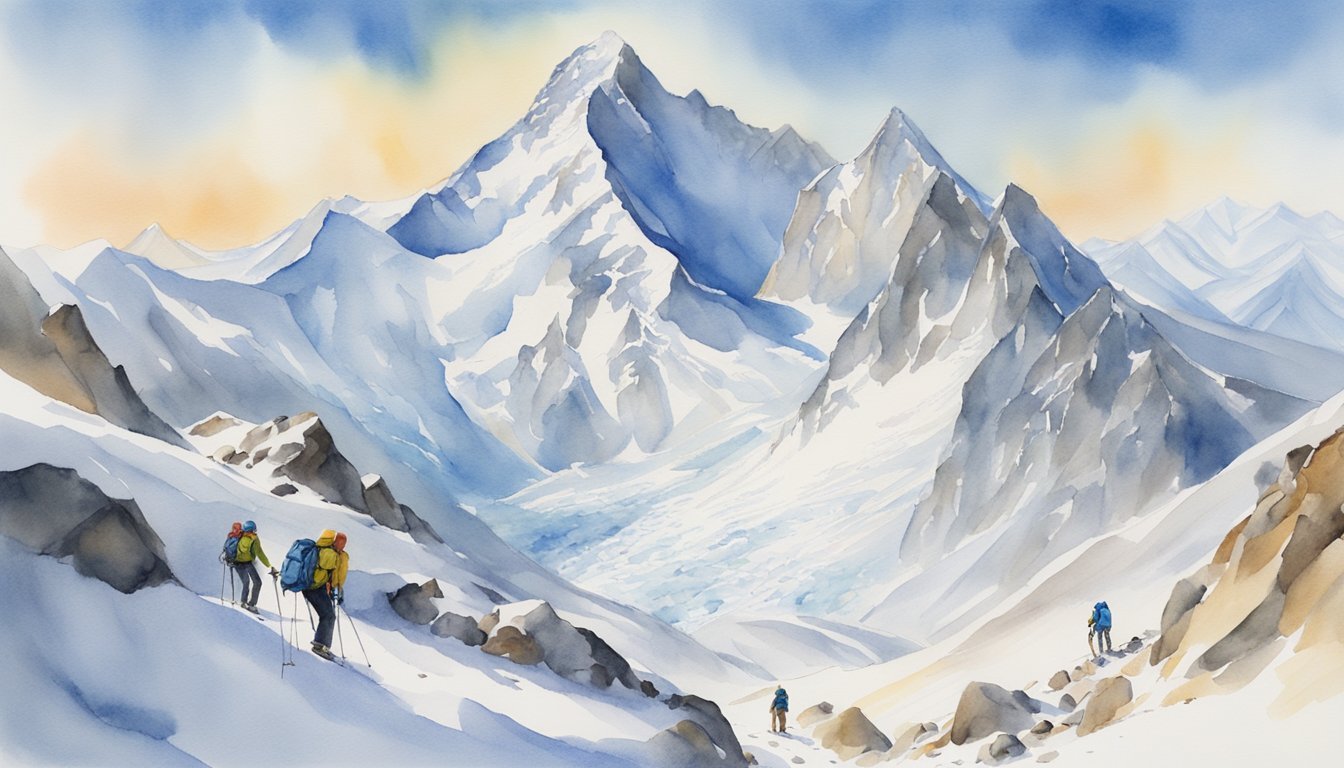K2 Climbing Essentials

When it comes to scaling K2, known as the Savage Mountain, mountaineers face a blend of extreme challenges and the rich history of climbing one of Earth’s most demanding peaks. This section covers the core aspects of a K2 expedition.
Understanding K2
K2 is the world’s second-highest mountain, straddling the border between Pakistan and China in the Karakoram Range. Its summit reaches 8,611 meters above sea level, and it is part of the renowned eight-thousander peaks. K2 is known for its treacherous weather, steep and icy slopes, and high fatality rate among climbers.
Historical Significance
The nickname “Savage Mountain” stems from its high difficulty level—it has the second-highest fatality rate among the eight-thousanders after Annapurna. The first successful ascent of K2 was achieved by an Italian expedition in 1954. This mountain is less frequently climbed than Mount Everest due to the extreme dangers involved.
The Climbing Community
Climbers, comprised of mountaineers, Sherpas, and porters, form a close-knit community with a shared passion for high-altitude climbing. Successful ascents often depend on collaborative international efforts and the support provided by highly experienced Sherpas.
Key Routes to the Summit
The standard route to the summit is the Abruzzi Spur, which is the go-to path for 75% of climbers. Other notable routes include the more remote and demanding North Ridge from the Chinese side and the Cesen Route, which offers slightly less technical climbing.
Gear and Preparation
Climbers must carry specialized gear such as crampons for ice, durable gloves, a robust helmet, and protective sunglasses. Weather conditions can rapidly change, making a reliable headlamp essential for night traverses. Mountaineers also often use supplemental oxygen due to the thin air in the “death zone” above 8,000 meters. Advanced preparation and acclimatization are crucial for attempting the summit, requiring weeks of adapting to the altitude and the terrain of ice, rock, and snow.
How Do Climbing Strategies for K2 Compare to Planning for the Everest Base Camp Trek?
Climbing strategies for K2 emphasize technical skills and altitude acclimatization, contrasting with the more straightforward logistics of an everest base camp adventure. While K2 demands rigorous preparation and experience, the Everest Base Camp trek focuses on endurance and well-planned itineraries to ensure a safe journey amidst stunning Himalayan landscapes.
Logistics and Challenges

Embarking on a K2 expedition is not only a test of climbing prowess but also a complex logistical challenge requiring meticulous planning, financial commitment, and physical preparation. Climbers must appreciate the arduous journey that lies ahead, marked by rugged terrain and unpredictable weather conditions.
Physical and Mental Demands
Trekking to K2’s base camp and climbing the mountain itself places immense physical and mental strain on mountaineers. They face steep slopes, treacherous icefalls, and the very real risk of avalanches. Mental resilience is crucial, as climbers endure isolation, extreme weather, and the ever-present danger inherent in high-altitude mountaineering.
Cost and Planning an Expedition
Organizing a K2 climb demands considerable financial investment, often exceeding tens of thousands of dollars per person. Costs encompass permits, travel expenses to and from base camp, supplies, and paying a team of support staff including experienced guides. The Climb K2 expedition requires extensive planning for acclimatization and includes contingency time for weather delays.
Base Camp Life
Life at base camp involves daily routines to maintain health and morale over weeks of waiting for an optimal summit window. The camp serves as a hub for planning the ascent, organizing supplies, and acclimatizing to the altitude. It’s a temporary home where climbers forge bonds with their team.
Coping with Altitude
Acclimatization is a slow but vital process to adapt to lower oxygen levels at high altitudes. Climbers often trek between base camp and various higher camps to acclimate their bodies. Coping with altitude is a delicate balance, as altitude sickness can strike even the most experienced climbers, and the use of supplemental oxygen is a common strategy to mitigate its effects.
Safety and Survival
Safety on K2 is paramount, with climbers wholly dependent on their skills, the expertise of their guides, and proper use of equipment such as fixed ropes. The history of K2 expeditions recounts numerous examples of the mountain’s danger, with only a small fraction of attempts ending successfully and without incident. Each step taken on K2 is a measure of survival, necessitating constant vigilance and respect for the mountain’s power.

